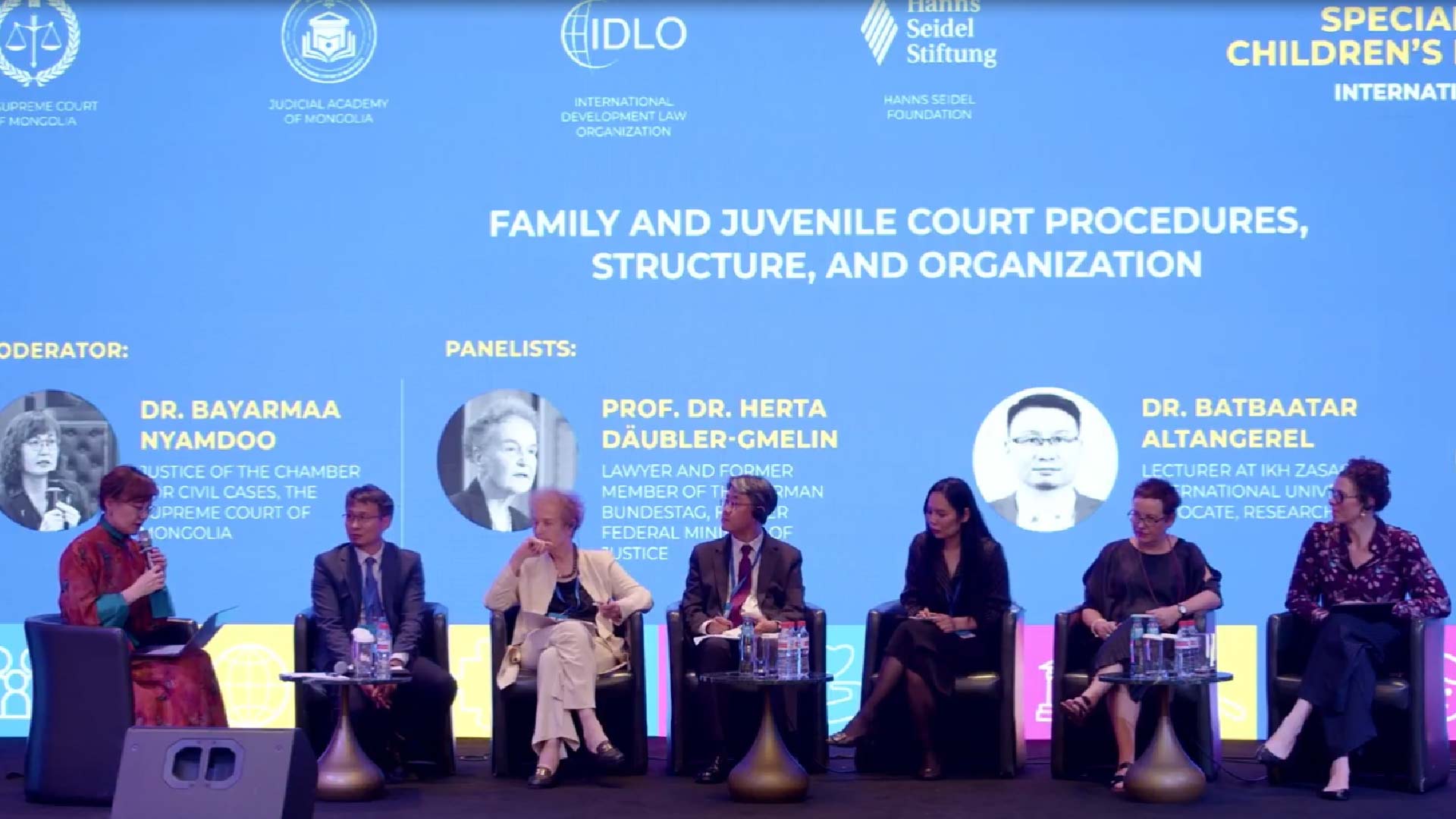Түлхүүр үг: Үндсэн бүтцийн сургаал, үндсэн эрх, төрийн албан ёсны хэл, хүний эрх, эрх чөлөө, тэгш эрх.
Abstract:This article presents a comparative analysis of the Constitutions of Mongolia (1992) and the Republic of India (1950), focusing on their structural features, historical development, forms of government, presidency, judicial frameworks, administrative organization at central and local levels, constitutional amendment procedures, the status of official languages, and the application of India’s “Basic Structure Doctrine.” The Indian Constitution, recognized as one of the most detailed in the world, comprises 25 parts, 448 articles, 12 schedules, and several annexes. Upon its adoption in 1950, India was proclaimed a “SOVEREIGN, SOCIALIST, SECULAR, DEMOCRATIC, REPUBLIC,” with significant amendments in 1976 reaffirming its commitment to a democratic order. The Constitution establishes a parliamentary system within a federal framework, firmly upholding democratic principles and fundamental rights through the inviolable "basic structure doctrine."
In contrast, the Constitution of Mongolia, consisting of 6 chapters and 70 articles, laid the groundwork for a democratic legal state during a period of major political and economic transformation. Although more concise, it has undergone over 40 amendments in 30 years to respond to national needs—while India has enacted over 100 amendments in 75 years—demonstrating dynamic constitutional development in both countries.
This comparative study highlights both convergences and divergences in constitutional design and implementation. It underscores the theoretical and practical value of cross-jurisdictional learning for enhancing legal systems, advancing constitutional reforms, and reinforcing the rule of law through shared legal insights among scholars, practitioners, and policymakers.
Key word: basic structure doctrine, fundamental rights, official language of state, human right, freedom, еqual rights.
Key word: basic structure doctrine, fundamental rights, official language of state, human right, freedom, еqual rights.
Бүртгэлтэй бол нэвтрэх | Бүртгэлгүй бол бүртгүүлэх
1) If I find the Constitution being misused, I shall be the first to burn it Dr. B.R. Ambedkar once said, “If I find the Constitution being misused, I shall be the first to burn it” (qtd. in Kumar 85).
2) "Democracy is not merely a form of government. It is primarily a mode of associated living, of conjoint communicated experience"Ambedkar, B.R. Dr. Babasaheb Ambedkar: Writings and Speeches, vol. 1, Government of Maharashtra, 1979.
3) Ambedkar, B.R. Constituent Assembly Debates, vol. 7, Lok Sabha Secretariat, 4 Nov. 1948, https://cadindia.clpr.org.in/constitution_assembly_debates/volume/7/1948-11-04.
4) “Freedom of mind is the real freedom” Ambedkar, B.R. Dr. Babasaheb Ambedkar: Writings and Speeches, vol. 1, Government of Maharashtra, 1979. Ambedkar.org, https://www.ambedkar.org/impdocs.htm.
5) GSCE Publications. “Structure of the Indian Constitution.” GSCE Publications, www.gscep.com/structure-of-indian-constitution.html.
6) “Structure of the Constitution.” Vajiram & Ravi, Vajiramandravi.com, vajiramandravi.com/quest-upsc-notes/important-articles-of-indian-constitution/.
7) Монгол улсын 1940 оны “Үндсэн хууль”
8) Монгол улсын 1960 оны “Үндсэн хууль”
9) National Parliaments: India.” Library of Congress, www.loc.gov/item/guide-to-law-online/india/
10) “Parliament.” Know India, Government of India, knowindia.india.gov.in/profile/the-union/legislature.php
11) The Constitution of India. Government of India, Ministry of Law and Justice, 1950. Article 83(1).
12) Austin, Granville. The Indian Constitution: Cornerstone of a Nation. Oxford UP, 1966.
13) Bakshi, P. M. The Constitution of India. 15th ed., Universal Law Publishing, 2019.
14) Reynolds, Andrew, Ben Reilly, and Andrew Ellis.
15) Electoral System Design: The New International IDEA Handbook. Stockholm, International IDEA, 2005. pp. 27–30.
16) https://legalinfo.mn/mn/detail?lawId=367
17) “President of India.” Drishti IAS, www.drishtiias.com/judiciary/president-of-india
18) Elected members of the Legislative Assemblies of all States and Union Territories possessing legislatures (e.g., Delhi, Puducherry, Jammu & Kashmir)
19) “Election of President.” Election Commission of India, https://eci.gov.in/constitutional-provisions/election-of-president/
20) Constitution of India. Government of India, Ministry of Law and Justice, 1950. Articles 54–55.
21) The Constitution of India. Government of India, Ministry of Law and Justice, 1950. Articles 32, 131, 136, 141, 142, 143, 226.
22) Basu, Durga Das. Introduction to the Constitution of India. LexisNexis, 2020.
23) Austin, Granville. The Indian Constitution: Cornerstone of a Nation. Oxford University Press, 1966.
24) "States and Union Territories of India." Know India, Government of India, knowindia.india.gov.in/states-uts/.
25) "Union Territory." Encyclopædia Britannica, Encyclopædia Britannica, Inc., www.britannica.com/topic/union-territory.
26) “Amendment of the Constitution of India.” Encyclopædia Britannica, Encyclopædia
27) Britannica, Inc., www.britannica.com/topic/Constitution-of-India/Amendments
28) “Article 368.” Constitution of India, ConstitutionofIndia.net, www.constitutionofindia.net/articles/article-368-power-of-parliament-to-amend-the-constitution-and-procedure-therefor/
29) Austin, Granville. The Indian Constitution: Cornerstone of a Nation. Oxford UP, 1966.
30) Basu, Durga Das. Introduction to the Constitution of India. 24th ed., LexisNexis, 2020.
31) Sridhar, Madabhushi. Constitutional Law of India: Doctrine of Basic Structure. Asia Law House, 2011.
32) India. The Constitution of India. Government of India, Ministry of Law and Justice, 1950. Art. 368.
33) “Ethnic Relations in India.” Wikipedia, Wikimedia Foundation, en.wikipedia.org/wiki/Ethnic_relations_in_India. “India at a Glance: Profile.” India.gov.in, Government of India, www.india.gov.in/india-glance/profile.
34) “Eighth Schedule of the Indian Constitution.” Drishti IAS, www.drishtiias.com/daily-news-analysis/eighth-schedule-of-the-indian-constitution.
35) “Scheduled Languages in India.” Department of Official Language, Ministry of Home Affairs, Government of India, rajbhasha.gov.in/en/languages-included-eighth-schedule-indian-constitution.
36) "Constitutional Provisions." Department of Official Language, Ministry of Home Affairs, Government of India, rajbhasha.gov.in/en/constitutional-provisions.
37) "Eighth Schedule of the Indian Constitution." Drishti IAS, www.drishtiias.com/daily-news-analysis/eighth-schedule-of-the-indian-constitution
38) “Languages in Judiciary.” Department of Justice, Ministry of Law and Justice, Government of India, doj.gov.in
39) “Language of the Courts in India.” Optimize IAS, optimizeias.com/language-of-the-courts-in-india/.
40) “Indian Judiciary: Supreme Court.” Animal Law India, www.animallawindia.com/supreme-court.
МЭДЭЭ, МЭДЭЭЛЭЛ

Сюзанн Митчелл: АНУ-д холбооны шүүгчдийг насаар нь томилдог, цалинг нь бууруулдаггүй
1 day ago

“Дагнасан шүүхийн тогтолцоо: Хүүхдийн эрх ашиг ба гэр бүл” олон улсын эрдэм шинжилгээний хурал (III хэсэг)
5 days ago

“Дагнасан шүүхийн тогтолцоо: Хүүхдийн эрх ашиг ба гэр бүл” олон улсын эрдэм шинжилгээний хурал (II хэсэг)
1 week ago

S2EP22. А.Түвшинтөгс: Бэлэглэлийн гэрээг хүчингүй болгох болон хүчин төгөлдөр бус тооцсон талаар маргаан шийдвэрлэсэн шүүхийн шийдвэрт хийсэн дүн шинжилгээ
1 week ago
ШҮҮХИЙН ШИЙДВЭРИЙН ХУРААНГУЙ
-
Фидуцийн гэрээний дагуу тээврийн хэрэгслийн өмчлөгчөөр бүртгэгдсэн нь учирсан хохирлыг хариуцан арилгах үндэслэл болохгүй
2025-07-04
-
Үндсэн хуулийг дагаж мөрдөхөөс өмнөх хууль, шийдвэрийг Цэц хянахгүй байх нь Үндсэн хууль зөрчсөн тухай Цэцийн тогтоол (2024, №02)-ын тойм
2025-07-03
-
Зээлийн гэрээ байгуулсан төдийгөөр биш, зээл авах хүсэл зоригоо илэрхийлсэн этгээд нь зээлийн үүргийг хариуцна
2025-07-02
-
Энхбат Төгөлдөр
2025-07-04 Бакалаврын ажилдуудаж байна ! -
Элбэгзаяагийн Төгстөгөлдөр
2025-07-04 Магистрын ажилдуудаж байна ! -
Элбэгзаяагийн Төгстөгөлдөр
2025-07-03 Бакалаврын ажилдуудаж байна ! -
Judilogy
2025-07-02 Мэдээллийн хуудасдуудаж байна ! -
Ганбат Мөнхтулга
2025-07-02 Эрдэм шинжилгээний өгүүлэлдуудаж байна ! -
Элбэгзаяагийн Төгстөгөлдөр
2025-07-01 Эрдэм шинжилгээний өгүүлэлдуудаж байна ! -
Эрхэмбаярын Энхцэцэг
2025-07-01 Эрдэм шинжилгээний өгүүлэлдуудаж байна ! -
Нээлттэй Нийгэм Форум Ө.Болортуяа, Б.Ганцэцэг, М.Насанбат, Н.Номинзул
2025-06-30 Эрх зүйн шүүмждуудаж байна ! -
Элбэгзаяагийн Төгстөгөлдөр
2025-06-30 Эрдэм шинжилгээний өгүүлэлдуудаж байна ! -
Ганбат Мөнхтулга
2025-06-26 Эрдэм шинжилгээний өгүүлэлдуудаж байна !